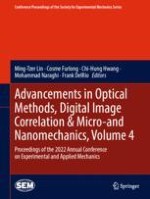Advancements in Optical Methods, Digital Image Correlation & Micro-and Nanomechanics, Volume 4 of the Proceedings of the 2022 SEM Annual Conference & Exposition on Experimental and Applied Mechanics, the fourth volume of six from the Conference, brings together contributions to this important area of research and engineering. The collection presents early findings and case studies on a wide range of optical methods ranging from traditional photoelasticity and interferometry to more recent DIC and DVC techniques, and includes papers in the following general technical research areas:
DIC Methods & Its Applications
Photoelsticity and Interferometry Applications
Micro-Optics and Microscopic Systems
Multiscale and New Developments in Optical Methods
Extreme Nanomechanics
In-Situ Nanomechanics
Expanding Boundaries in Metrology
Micro and Nanoscale Deformation
MEMS for Actuation, Sensing and Characterization
1D & 2D Materials
